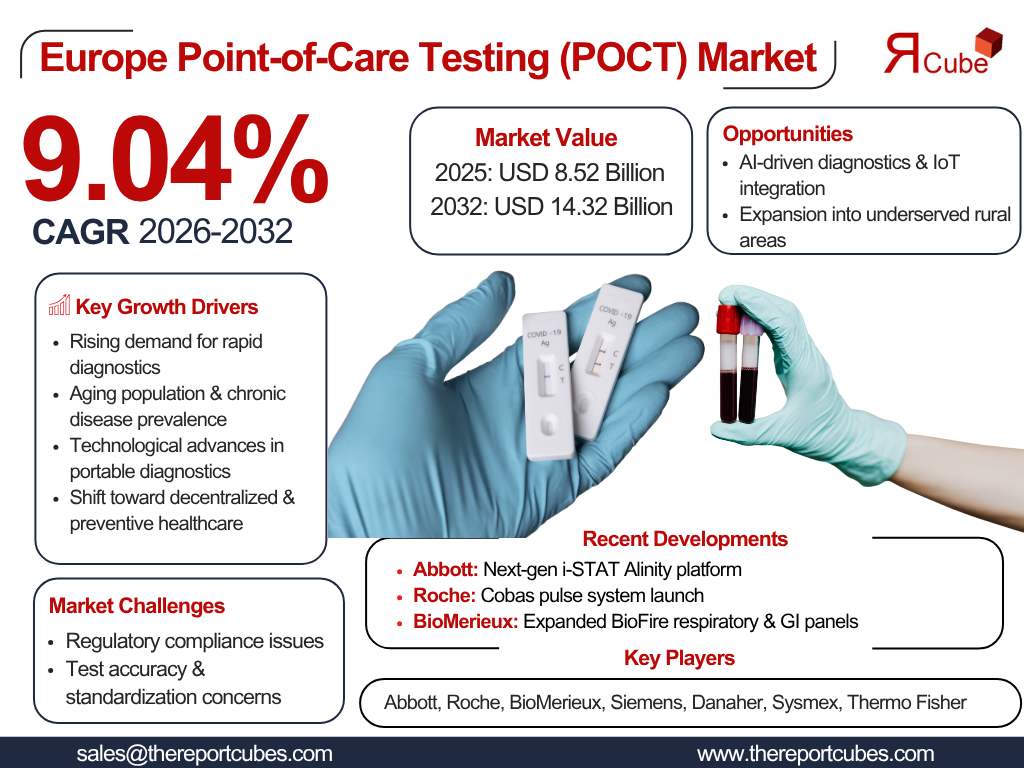Why Europe’s Point-of-Care Testing Market is Booming – $8.52B in 2025 to $14.32B by 2032

Introduction
Point-of-care testing (POCT) is transforming healthcare by enabling rapid diagnostic tests outside traditional laboratory settings. In Europe, the POCT market is experiencing significant growth due to advancements in technology, increasing demand for decentralized testing, and the rising prevalence of chronic and infectious diseases.
According to a recent study by Report Cube, the Europe POCT Market was valued at USD 8.52 billion in 2025 and is projected to grow at a CAGR of 9.04% from 2026 to 2032, reaching approximately USD 14.32 billion by 2032. This growth is driven by factors such as the need for faster diagnostics, government support for healthcare innovation, and the increasing adoption of portable testing devices.
What is Point-of-Care Testing (POCT)?
POCT refers to medical diagnostic testing conducted near the patient, often at the bedside, in clinics, or even at home. Unlike traditional lab tests, POCT provides real-time results, allowing for quicker medical decisions. Common POCT applications include:
- Blood glucose monitoring (for diabetes management)
- Infectious disease testing (COVID-19, HIV, flu)
- Cardiac marker tests (for heart attacks)
- Coagulation testing (for blood clotting disorders)
- Pregnancy and fertility tests
Key Drivers of the Europe POCT Market
1. Rising Prevalence of Chronic and Infectious Diseases
Europe faces a growing burden of chronic diseases such as diabetes, cardiovascular diseases, and respiratory illnesses. POCT devices help in early detection and continuous monitoring, improving patient outcomes. Additionally, the post-pandemic era has increased demand for rapid infectious disease testing.
2. Technological Advancements in POCT Devices
Innovations such as wearable sensors, smartphone-connected devices, and AI-powered diagnostics are enhancing POCT efficiency. Portable analyzers and microfluidic technologies allow for highly accurate, lab-quality results in minutes.
3. Government Support and Regulatory Approvals
European governments and regulatory bodies (such as the European Medicines Agency (EMA) and CE marking) are promoting POCT adoption by streamlining approvals for new devices. Policies favoring decentralized healthcare are also boosting market growth.
4. Increasing Demand for Home-Based Testing
The shift towards personalized and home healthcare is accelerating POCT adoption. Patients with chronic conditions prefer self-testing devices for convenience, reducing hospital visits.
5. Aging Population and Healthcare Cost Pressures
Europe’s aging population requires frequent medical monitoring, increasing reliance on POCT. Additionally, POCT reduces healthcare costs by minimizing hospital stays and lab expenses.
Market Segmentation
By Product Type
- Glucose Monitoring (Largest segment due to high diabetes prevalence)
- Infectious Disease Testing (Rapid flu, COVID-19, and STI tests)
- Cardiometabolic Testing (Cholesterol, cardiac markers)
- Coagulation Testing (For patients on blood thinners)
- Pregnancy & Fertility Tests
By End-User
- Hospitals & Clinics (Primary adopters of POCT)
- Home Care Settings (Growing due to remote monitoring trends)
- Diagnostic Laboratories
- Pharmacies (Offering over-the-counter POCT kits)
By Country
- Germany, UK, France, Italy, and Spain lead the market due to strong healthcare infrastructure.
- Eastern Europe is witnessing rapid growth due to increasing healthcare investments.
Challenges in the Europe POCT Market
Despite its growth, the POCT market faces some hurdles:
- Regulatory complexities across different European countries.
- High costs of advanced POCT devices, limiting adoption in low-income regions.
- Accuracy concerns compared to traditional lab tests (though improving with new tech).
Future Outlook (2026-2032)
The Europe POCT market is set for strong expansion, with key trends including:
- Expansion of AI and IoT in POCT – Smart diagnostics integrating with electronic health records.
- Growth of decentralized testing – More tests shifting from labs to pharmacies and homes.
- Increased focus on infectious disease POCT – Post-pandemic demand for rapid testing solutions.
Conclusion
The Europe Point-of-Care Testing (POCT) Market is on a robust growth trajectory, driven by technological advancements, rising disease prevalence, and healthcare decentralization. With an expected CAGR of 9.04%, the market is projected to reach USD 14.32 billion by 2032, offering significant opportunities for manufacturers, healthcare providers, and patients alike.





